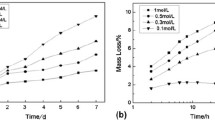Porous preforms of B4C + C and B4C + C + Si materials were impregnated by liquid (molten) silicon to obtain high-density product with a relative density of 99.0 % and porosity of 0.9%. Silicon impregnation was carried out by saturating the samples through the pores of the SiC + C sacrificial preforms. This method allows to reduce both the dissolution of boron carbide grains in the silicon solution and the formation of the B12(C, Si, B)3 phase. This reduces the fragility of the product and thereby improves the mechanical characteristics of the B4C ceramics.




Similar content being viewed by others
References
A. K. Suri, C. Subramanian, J. K. Sonber, and T. C. Murthy, “Synthesis and consolidation of boron carbide: a review,” Int. Mater. Rev., 55(1), 4 – 40 (2010).
P. Larsson, N. Axen, and S. Hogmark, “Improvements of the microstructure and erosion resistance of boron carbide with additives,” J. Mater. Sci., 35(14), 3433 – 3440 (2000).
N. Cho, Z. Bao, and R. F. Speyer, “Density- and hardness-optimized pressureless sintered and post-hot isostatic pressed B4C,” J. Mater. Res., 20(8), 2110 – 2116 (2005).
X. Du, Z. Zhang, Y. Wang, et al., “Hot-pressing kinetics and densification mechanisms of boron carbide,” J. Am. Ceram. Soc., 98(5), 1400 – 1406 (2015).
J. H. Chae, J. S. Park, J. P. Ahn, and K. H. Kim, “Mechanical properties of B4C ceramics fabricated by a hot-press sintering,” J. Korean Ceram. Soc., 46(1), 81 – 85 (2009).
H. Lee and R. F. Speyer, “Pressureless sintering of boron carbide,” J. Am. Ceram. Soc., 86(9), 1468 – 1473 (2003).
C. P. Zhang, H. Q. Rue, X. Y. Yue, and W. Wang, “Studies on the RBBC ceramics fabricated by reaction bonded SiC,” Rare Metal Mater. Eng., 40, 536 – 539 (2011).
P. Barick, D. C. Jana, and N. Thiyagarajan, “Effect of particle size on the mechanical properties of reaction bonded boron carbide ceramics,” Ceram. Int., 39(1), 763 – 770 (2013).
C. Zhang, H. Ru, H. Zong, et al., “Coarsening of boron carbide grains during the infiltration of porous boron carbide pre-forms by molten silicon,” Ceram. Int., 42(16), 18681 – 18691 (2016).
N. A. Golubeva, L. A. Plyasunkova, I. Yu. Kelina, et al., “Study of reaction-bonded boron carbide properties,” Refract. Ind. Ceram., 55(5), 414 – 418 (2015).
X. Li, D. Jiang, J. Zhang, et al., “Reaction-bonded B4C with high hardness,” Int. J. Appl. Ceram. Technol., 13(3), 584 – 592 (2016).
Y.Wang, S. Tan, and D. Jiang, “The effect of porous carbon preform and the infiltration process on the properties of reaction-formed SiC,” Carbon, 42(8), 1833 – 1839 (2004).
J. C. Margiotta, D. Zhang, D. C. Nagle, and C. E. Feeser, “Formation of dense silicon carbide by liquid silicon infiltration of carbon with engineered structure,” J. Mater. Res., 23(5), 1237 – 1248.
S. Xu, G. Qiao, D. Li, et al., “Reaction forming of silicon carbide ceramic using phenolic resin derived porous carbon preform,” J. Europ. Ceram. Soc., 29, No. 11, 2395 – 2402 (2009).
D. D. Nesmelov and S. N. Perevislov, “Reaction sintered materials based on boron carbide and silicon carbide,” Glass Ceram., 71(9/10), 313 – 319 (2015).
S. Hayun, A.Weizmann, M. P. Dariel, and N. Frage, “The effect of particle size distribution on the microstructure and the mechanical properties of boron carbide-based reaction-bonded composites,” Int. J. Appl. Ceram. Technol., 6(4), 492 – 500 (2009).
D. Mallick, T. K. Kayal, J. Ghosh, et al., “Development of multi-phase B–Si–C ceramic composite by reaction sintering,” Ceram. Int., 35(4), 1667 – 1669 (2009).
Y.-X.Wang, Sh.-H. Tan, and D.-L. Jiang, “The fabrication of reaction-formed silicon carbide with controlled microstructure by infiltrating a pure carbon preform with molten Si,” Ceram. Int., 30(3), 435 – 439 (2004).
S. Hayun, A. Weizmann, M. P. Dariel, and N. Frage, “Microstructural evolution during the infiltration of boron carbide with molten silicon,” J. Europ. Ceram. Soc., 30(4), 1007 – 1014 (2010).
M. P. Dariel and N. Frage, “Reaction bonded boron carbide: recent developments,” Adv. Appl. Ceram., 111(5/6), 301 – 310 (2012).
S. N. Perevislov, “Mechanism of liquid-phase sintering of silicon carbide and nitride with oxide activating additives,” Glass Ceram., 70(7/8), 265 – 268 (2013).
V. Sirota, O. Lukianova, V. Krasilnikov, et al., “Microstructural and physical properties of magnesium oxide-doped silicon nitride ceramics,” Results in Physics, 6, 82 – 83 (2016).
The study was carried out with the financial support of the Russian Foundation for Basic Research, project No. 17-03-00863\17.
Author information
Authors and Affiliations
Corresponding author
Additional information
Translated from Novye Ogneupory, No. 1, pp. 33 – 37, January 2018.
Rights and permissions
About this article
Cite this article
Perevislov, S.N., Shcherbak, P.V. & Tomkovich, M.V. High Density Boron Carbide Ceramics. Refract Ind Ceram 59, 32–36 (2018). https://doi.org/10.1007/s11148-018-0178-4
Received:
Published:
Issue Date:
DOI: https://doi.org/10.1007/s11148-018-0178-4




